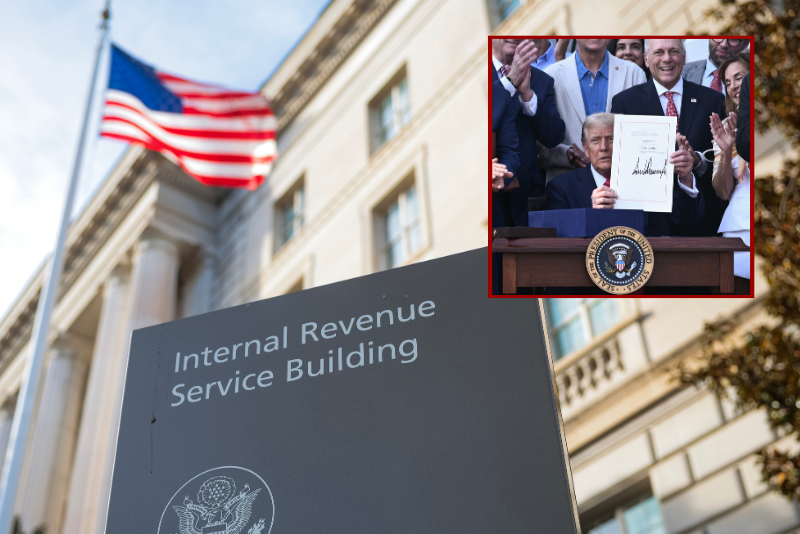
OAN Staff Brooke Mallory
1:54 PM – Friday, October 10, 2025
The Internal Revenue Service (IRS) has released its annual adjustments for the 2026 tax year, affecting more than 60 tax provisions, including income tax brackets, standard deductions, and key credits.
The IRS’s inflation adjustments will help prevent “bracket creep,” and will ease the tax burden for Americans.
Thanks to policies enacted under President Donald Trump, which set the stage for adjusted tax thresholds, standard deductions, and key credits, Americans are now able to keep more of their hard-earned income, protecting them from being pushed into higher tax brackets simply because of rising prices — rather than real income growth.
Under Trump’s “One Big, Beautiful Bill” (OBBB), the standard deduction for married couples filing jointly will rise to $32,200 in 2026, up from $31,500 in 2025. Single filers and married individuals filing separately will also see a deduction of $16,100, while heads of households will benefit from a deduction of $24,150.
Tax Brackets Adjusted
While the top federal income tax rate remains 37%, income thresholds have shifted slightly.
- 35% rate for incomes over $256,225 ($512,450 for joint filers)
- 32% rate for incomes over $201,775 ($403,550 for joint filers)
- 24% rate for incomes over $105,700 ($211,400 for joint filers)
- 22% rate for incomes over $50,400 ($100,800 for joint filers)
- 12% rate for incomes over $12,400 ($24,800 for joint filers)
- 10% rate for incomes at or below $12,400 ($24,800 for joint filers)
Key Credits and Exemptions Boosted
Taxpayers can also expect higher credits in several categories starting in 2026.
- Alternative Minimum Tax (AMT) exemption rises to $90,100 for singles and $140,200 for joint filers
- Estate tax exclusion increases to $15 million
- Adoption credit rises to $17,670, with $5,120 potentially refundable
- Employer-provided childcare credit jumps from $150,000 to $500,000 ($600,000 for small businesses)
- Earned Income Tax Credit (EITC) for families with three or more children climbs to $8,231
Other indexed benefits include increases to transportation and parking fringe benefits, health flexible spending accounts, medical savings accounts, and the foreign earned income exclusion. Commuter and parking perks increase to $340 per month, while health flexible spending accounts now allow contributions up to $3,400.
Medical savings accounts see higher deductible and out-of-pocket limits, and the foreign earned income exclusion climbs to $132,900.
| Benefit | 2026 Limit | 2025 Limit (for comparison) | Source |
| Qualified Transportation Fringe Benefit (e.g., transit passes, vanpools) | $340 per month | $325 per month | IRS |
| Qualified Parking Fringe Benefit | $340 per month | $325 per month | IRS |
| Health Flexible Spending Account (FSA) Contribution Limit | $3,400 | $3,300 | IRS |
| Health FSA Unused Funds Carryover Limit | $680 | $660 | IRS |
| Medical Savings Account (MSA) Minimum Deductible (Family Coverage) | $5,850 | $5,700 | IRS |
| MSA Maximum Deductible (Family Coverage) | $8,750 | $8,550 | IRS |
| MSA Out-of-Pocket Expense Limit (Family Coverage) | $10,700 | $10,500 | IRS |
| Foreign Earned Income Exclusion | $132,900 | $130,000 | IRS |
However, some items are unaffected by the adjustments.
Personal exemptions remain at $0, itemized deduction limits stay permanently modified, and the Lifetime Learning Credit phase-out thresholds have not changed.
The IRS’s recent announcement regarding the 2026 federal income tax brackets and standard deductions doesn’t address Social Security benefits. However, the OBBB, which influenced these adjustments, includes provisions that may indirectly affect Social Security recipients.
A new $6,000 federal tax deduction has been introduced for seniors starting in 2025 — anticipated to benefit those whose Social Security income is taxable. This deduction is subject to income-based phaseouts and is available even for itemizers.
Stay informed! Receive breaking news blasts directly to your inbox for free. Subscribe here. https://www.oann.com/alerts
What do YOU think? Click here to jump to the comments!
Sponsored Content Below

